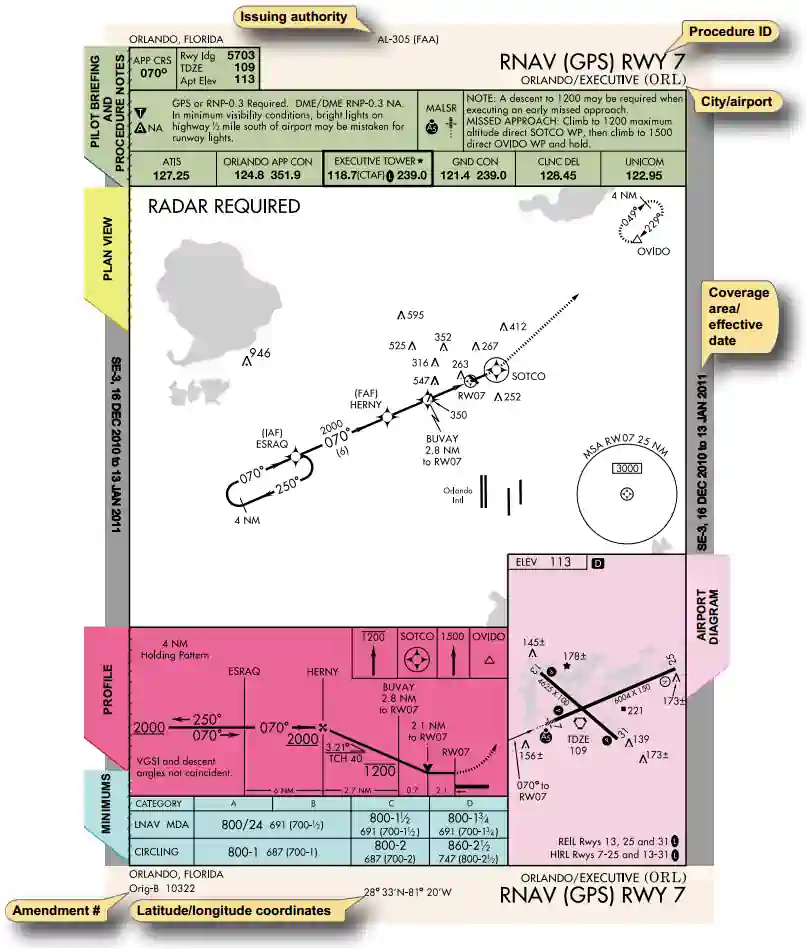Approach Briefing
An approach briefing is a pilot and passenger's review and confirmation of the expected approach procedure.
Introduction to Approach Briefing
- Airports can have multiple approaches to multiple runways, which makes memorizing approach procedures both unrealistic and unsafe.
- Therefore, it is through the approach briefing that you and your crew familiarize yourselves with the planned approaches.
- An approach briefing, as briefed by the pilot, sets expectations for the pilot and/or crew, keeping the aircrew ahead of the aircraft.
Briefing Contents
- Approach plates are logically sequenced to allow for the flow of an approach briefing. [Figure 1]
- Starting with the pilot briefing and procedure notes, the pilot covers administrative information such as:
- Approach name, airport, and page number (as required).
- Runway information, elevation.
- Approach notes.
- Approach lighting expected.
- Terminal area frequencies such as ATIS/AWOS, approach, and tower.
- The weather information provided allows for calculating crosswind components and expected performance parameters.
- Notes:
- It is not critical to read off each number or word verbatim as it appears.
- Brief what applies (i.e., don't brief clearance frequencies unless you expect to talk to them) and abbreviate as appropriate (i.e., ground will be on 0.4).
- The plan view doesn't offer much to discuss, but this section provides spatial awareness of the points and courses listed in the profile view.
- The profile view provides detailed information that covers:
- Step altitudes.
- Courses, to include the Final Approach Course.
- Fixes, to include the Final Approach Fix.
- The missed approach or climb-out instructions.
- Timing.
- Wake turbulence.
- This information feeds into the final portion of the approach, where the pilot needs to be aware of the minimum altitudes.
- In the minimums section, you can determine:
- Category.
- Weather minimums.
- Speeds.
- Decision Height (DH) or MDA.
- Lastly, the airport diagram enhances spatial awareness of the aircraft's orientation upon breaking out of the weather.
- Be sure to focus on items that are unusual or otherwise noteworthy.
- These items can be from the plate (notable terrain) or restrictions provided by Air Traffic Control.
Approach Briefing Example
- "We will be flying the VOR runway 16 approach into Daytona Beach International on page 22 of the Florida plates. The minimum weather requirements are 800 and 1. NAVAIDs are being tuned and set to 112.6 and 73x. We will fly to the IAF and turn outbound 336 down to 1600. Procedure turn back in on 156 until the FAF, where we will start the time and begin a descent to our MDA of 760. Our missed approach point will be 7.4 DME from the VORTAC. Missed approach instructions are climbing straight out at 2000 on the 161 radial to SMYRA to hold. We are on approach, set tower (as appropriate)."
Common Pitfalls
- Ensure you reference the correct approach plate for both the correct approach type and runway.
- Not reviewing the symbology on an approach plate (i.e., mistaking a no lower than for a no higher than).
- Using the wrong frequency to contact a specific agency.
- Not preparing for the next phase of flight, including post-landing taxi.
Approach Briefing Conclusion
- It is not necessary to go into such detail as to read each frequency, but rather to discuss the flow.
- Pilots must balance the requirement to brief essential elements while aviating, navigating, and communicating.
- Although not required by regulations for general aviation (part 91), they are a great idea to do regardless of experience level to make sure you plan correctly.
- The completeness and clarity of the approach brief are indicators of how well you are about to fly the approach.
- The briefing is for you, so tailor it however you want.
- Over time, your experiences may change, leading to constant re-development of your approach brief.
- Practice even when flying under Visual Flight Rules (VFR) so you can be proficient when operating under Instrument Flight Rules (IFR).
- To learn more about instrument procedures, be sure to check out the Instrument Procedures Handbook online or in paperback.
- Pilots can visit the FAA's Instrument Flight Procedures Information Gateway to review and submit questions about why certain procedures are structured as they are.
- Still looking for something? Continue searching:
